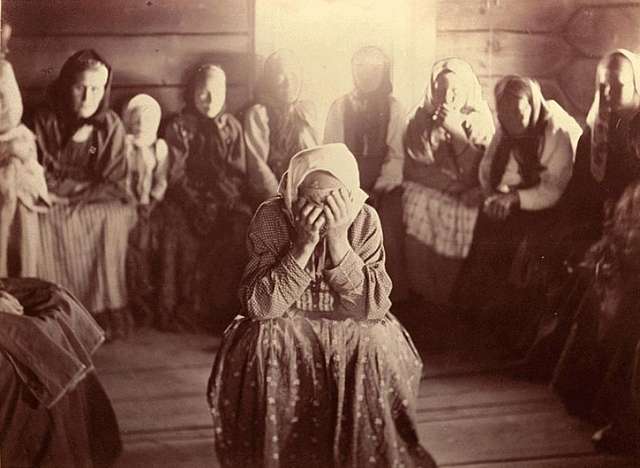Up until the middle of the last century, keening would often be heard at an Irish wake. However, how and why did this Irish tradition die out?

Keening is an ancient Irish tradition that involved women, and exclusively women, crying out loudly in grief and anguish to mourn the dead.
This tradition remained in Ireland for centuries, but by the middle of the 20th century, it was largely an old and outdated practice.
Let’s take a look into the origins and development of keening across the years and just why exactly it died out in Ireland.
What is keening? – an old Irish tradition

Keening was a vocal ritual performed at wakes or gravesides by women in Ireland, as well as less predominantly in Scotland when mourning the dead. It began around the 16th century and was carried out exclusively by women.
The word itself is the anglicised version of the Gaelic ‘caoineadh’, meaning ‘crying’. Women would gather around at a funeral or wake and wail in grief.
Sometimes, women were paid with a glass of whiskey to lament the dead with these vocal cries of anguish. The women would do this whether they knew the dead person or not. Essentially, some were paid actors.
While many believe the tradition to have roots in Ireland, it actually derives from various other cultures around the world.
The history of keening – derived from outside Ireland

Acts similar to keening have been portrayed throughout literature for centuries. Homer, the ancient Greek poet, wrote about female mourners who cried loudly in the 12th to 8th centuries BCE.
Plus, in the 5th century BCE, the Greek historian Herodotus described something similar to keening among Egyptian women and the women of Sparta.
The ancient Roman poet Virgil also referenced keening-like behaviour in the epic poem ‘Aeneid’, which was written in the 1st century BCE.
These precursors to keening often involved many similarities to the Irish ritual. These include wailing and crying loudly, physical movements like rocking and clapping, dishevelled appearances and beating of breasts.
Why did the tradition die out? – disapproval from the church

Once woven into Irish tradition, the practice has almost completely died out. The end of keening came about in the 1950s. The Catholic Church began to express disapproval of the tradition, as they said it came from paganism.
They would regard it as inappropriate. Families began to fear that to engage in the practice would appear backwards and they would be looked down on.
However, modern theorists assert that the real reason the church didn’t want keeners at funerals was because priests didn’t want to them to overshadow their sermons, especially because they were women.
The end of the tradition – an exploration into the end

Presenter Marie-Louise Muir explored the end of the tradition in a 2016 BBC Radio 4 documentary called ‘Songs for the Dead’.
In the documentary, Muir explains how priests started to feel uncomfortable with the presence of keeners at funerals coming to take over the mourning process after the priest had laid prayers over the body.
She said, “Can you imagine the awkwardness of the keener coming in and the ceding — the priest having to give way to this what I suppose he might have considered almost pagan custom? Where does the priest put himself?”
Muir believes that the lack of tradition in modern-day Ireland has actually led to our difficulty with mourning and grief.
Of this, she said, “Our grief now is too contained. We rely on taking anti-depressants. We go to a grief counsellor, but these people, in a way, letting it all out, having a good scream, coming from the feet up, a good cry, a good purging.”
Even if you didn’t partake in keening, it was a wholly cathartic experience. It was like putting a voice to grief.
Keening songs today – ancient practice through modern music
While keening has now died out almost entirely. However, there are still many enduring examples of Irish keening or funeral songs.
These songs are often played at modern funerals. They are beautiful pieces of music to lament the passing of a loved one.
These songs include ‘Song of Keening’ by Aine Minogue. An Irish singer and harpist, Minogue uses her intrinsic knowledge of keening to improvise and relate to it in the traditional style.
Another beautiful example is ‘Grief’ by the late Eithne Ní Uallacháin. She was a stunning and gifted singer and flautist. This particular song drew elements from an ancient lament called “Caoineadh Airt Uí Laoghaire”.
Now, keening has largely disappeared. However, you might still find the practice at a more traditional Irish wake in certain parts of the country among certain families.

